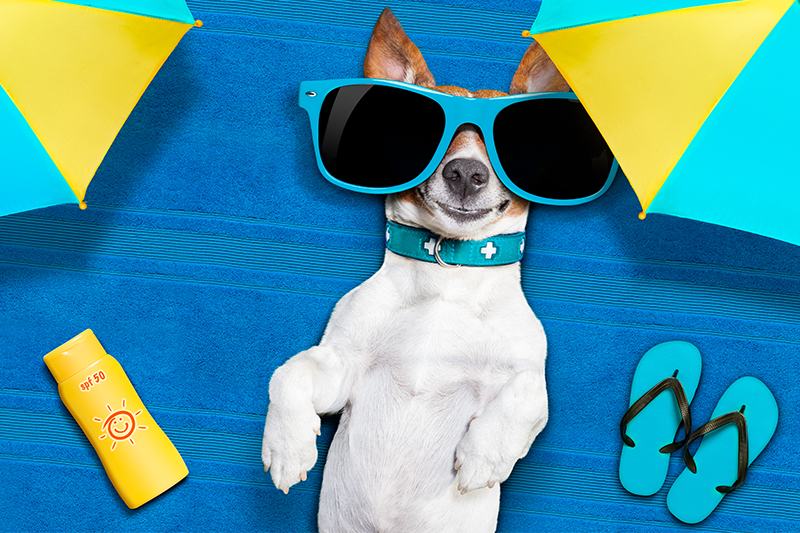Don’t Get Burned: The Facts On Pets and Sunscreen

Like humans, pets can get sunburned. Having fur doesn’t make them completely safe. While their fur offers some protection, there are still good reasons to provide additional sunscreen and sun protection.
At Lone Tree Veterinary Medical Center, we’re happy to explain the ins and outs of pets and sun protection. And and tips on keeping your pet protected and comfortable while summer days in the sun.
Why Do Pets Need Sunscreen?
There are various reasons why some pets need additional screening from the sun.
- Even with fur, pets get sunburnt, as well as other damage to their skin from overexposure to the sun.
- There are certain pets that require sun protection. Pets with light or white hair or skin, hairless breeds, or those with very short hair.
- Pets can also develop skin cancer from sun exposure over time.
- The tips of the ears, bridge of the nose, and other places where the hair is minimal are also vulnerable to sunburn and can be protected by a pet-specific sunscreen or block. Even your heavy, thick-coated pet may need sun protection on those sensitive parts of the body, especially, if in the sun often or for long periods of time.
The Right Kind of Sunscreen for Pets
Apply pet-specific sunscreen. Human grade sunscreens contain zinc oxide and salicylates that are toxic to pets. Since pets naturally want to lick their skin, these harmful ingredients can be ingested and cause poisoning. Symptoms such as stomach upset, vomiting, and more serious symptoms can occur, including, hemolytic anemia (damage to the red blood cells), which can be life-threatening.
There are several types of pet sunscreen/sunblock products on the market. You will find sprays and lotions, as well as balms that are used on exposed areas of the face. Be careful when selecting to make sure the product you choose is FDA approved and clearly specified as non-toxic to pets! When in doubt, check with your veterinarian for a recommendation.
When applying a sunscreen product, you should first test it in a small area on your pet to check for a reaction, as even a safe product can cause an allergic reaction and should not be used. You will also need to wipe the product off your pet with a damp towel when indoors or bathe your pet regularly to prevent product build-up.
After applying sunscreen to your pet, keep them indoors for 10 to 15 minutes to allow the sunscreen to absorb. If needed, distract your pet to prevent them from licking it off.
Finally, never apply tanning lotion, cream, or oil of any kind on your pet!
Other Forms of Pet Sun Protection
Pet sunscreen is only one of the ways you can keep your pet sunburn free this summer. Along with sunscreen or sunblock, you can rely on the following sun-smart measures for your four-legged pal.
- Opt for SPF (sun protection factor) clothing for your pet. These come in loose vests and shirts that protect the skin from the intense summer rays, but allow air to circulate and help with cooling.
- Choose Doggles or goggles designed for dogs. These are especially important for dogs with lighter colored eyes or have eye conditions that increase their sensitivity to light. This is also a good idea for high altitude hikes where the sun’s rays are more intense.
- Provide shade for your pet when outside. Whether that involves places to relax under shade trees, a shaded porch, or by setting up a large umbrella. Your pet should always have protection from the sun that provides a good amount of shade, regardless of the time of day.
- Limit your pet’s outdoor time to mornings and evenings.
A big part of sun safety is keeping your pet hydrated. Give your pet lots of water whenever it is outdoors, and offer extra water when on walks, hikes or during travel.
Other Questions About Pets and Sunscreen?
Do you have additional questions about using sunscreen on your pet safely and effectively? Please don’t hesitate to ask. We are here for all of your pet related questions!



